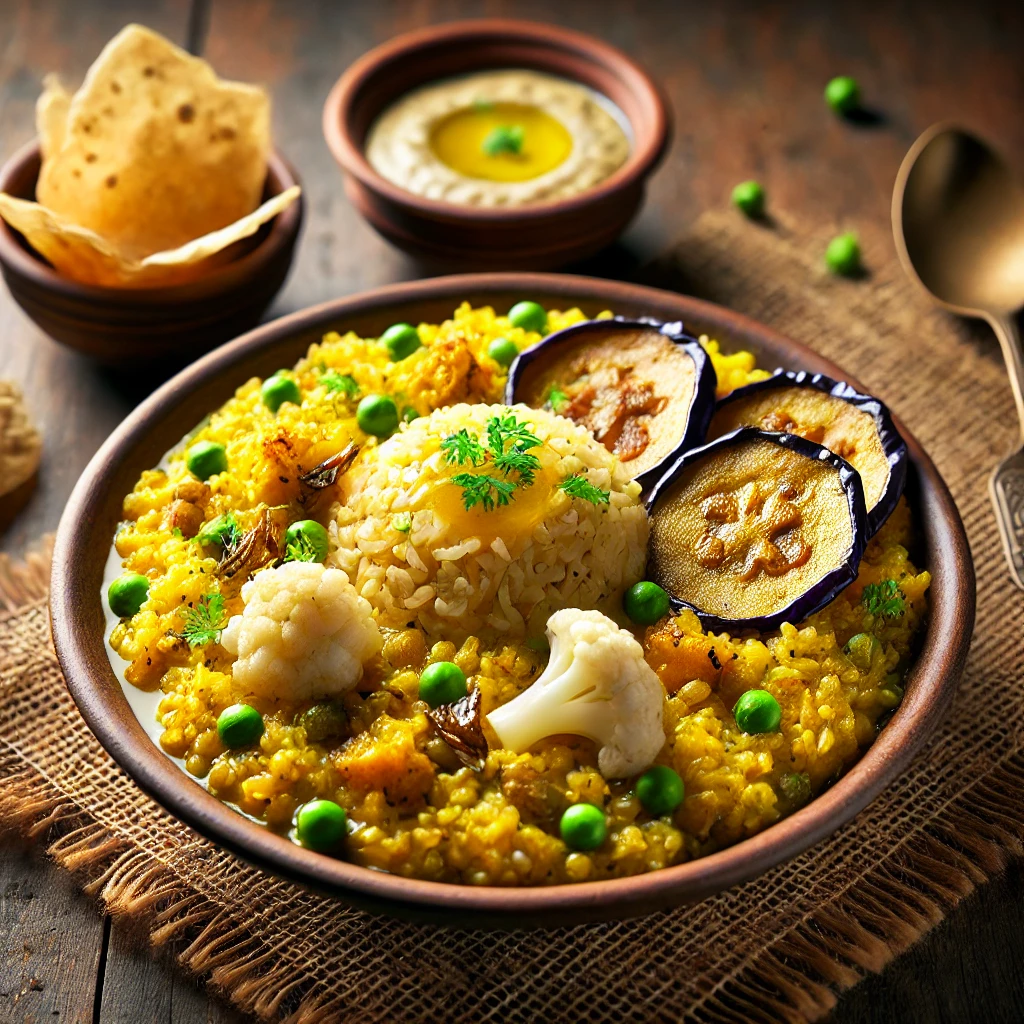Regional Varieties of Khichdi Across India: A Culinary Journey
Khichdi—a humble, one-pot dish—has been a staple in Indian households for centuries. Its simplicity, nutritional value, and adaptability make it a favorite comfort food across the nation. While the basic ingredients—rice, lentils, and spices—remain consistent, the preparation and flavor profiles of khichdi vary significantly across India. This blog explores the diverse regional varieties of khichdi, each reflecting the unique cultural and culinary traditions of its region.
1. Bengali Bhoger Khichuri

In West Bengal, khichdi, or “Khichuri,” takes on a festive avatar. It’s an integral part of puja offerings, especially during Durga Puja. Made with short-grain rice (like Gobindobhog) and moong dal, Bengali khichuri is flavored with ghee, ginger, and whole spices. Vegetables like cauliflower, peas, and potatoes are often added. It’s served with fried items like eggplant fritters (beguni) and a dollop of ghee for an aromatic finish.
2. Gujarati Vaghareli Khichdi
In Gujarat, khichdi is an everyday meal, often enjoyed with kadhi and pickles. The Vaghareli Khichdi (tempered khichdi) is enhanced with a tempering of mustard seeds, curry leaves, and spices. This version is usually made with rice, moong dal, and seasonal vegetables, giving it a mild yet flavorful taste. Sweetness, a hallmark of Gujarati cuisine, is sometimes added through a hint of jaggery.
3. Rajasthani Bajra Khichdi
Rajasthan’s arid climate influences its cuisine, and bajra (pearl millet) is a staple grain in the region. Bajra Khichdi is made by cooking crushed pearl millet with moong dal, spiced simply with turmeric and salt. Ghee is generously used, enhancing its richness. This hearty dish is typically served with curd, garlic chutney, or buttermilk.
4. South Indian Pongal
While not called khichdi, Pongal from Tamil Nadu is a close cousin. This savory dish is made with rice, split moong dal, black pepper, and ghee. A generous tempering of curry leaves, cashews, and ginger adds depth. Pongal is often prepared during the harvest festival of the same name, making it a dish deeply rooted in tradition and celebration.
5. Bihari Khichdi
In Bihar, khichdi is a staple, especially enjoyed on Saturdays or during festivals like Makar Sankranti. It is made with rice, moong dal, and seasonal vegetables like potatoes, carrots, and green peas. Bihari khichdi is traditionally served with accompaniments such as baingan bharta (mashed eggplant), papad, and chutneys, creating a wholesome and satisfying meal.
6. Maharashtrian Masala Khichdi
Maharashtrian khichdi is a spiced version, often referred to as Masala Khichdi. Alongside rice and toor dal, vegetables like tomatoes, carrots, and green beans are added. The use of goda masala, a special Maharashtrian spice blend, sets this khichdi apart, giving it a unique flavor. It’s commonly paired with pickle, yogurt, or a drizzle of lemon juice.
7. Uttar Pradesh’s Moong Dal Khichdi
In Uttar Pradesh, moong dal khichdi is synonymous with simplicity and comfort. Made with minimal spices, this dish is light on the stomach and often prepared for people recovering from illness. It’s served with a dollop of ghee and sides like fried potatoes or kadhi, offering a balance of taste and nutrition.
8. Sindhi Khichdi
Sindhi cuisine offers a unique version of khichdi, often made with basmati rice and split green moong dal. This version is seasoned with simple spices like cumin and turmeric. The hallmark of Sindhi khichdi is its accompaniments, which often include sai bhaji (a spinach and lentil curry), pickles, and papad.
9. Karnataka’s Bisi Bele Bath
Bisi Bele Bath, a famous dish from Karnataka, is essentially a spiced khichdi with a twist. Made with rice, toor dal, tamarind, and a special masala blend, this dish is bursting with flavors. Vegetables like carrots, beans, and capsicum are added, and it’s typically garnished with fried cashews and served with boondi or chips for a crunchy contrast.
10. Punjabi Khichdi
In Punjab, khichdi is enriched with ghee and a generous helping of spices. Often made with basmati rice and moong dal, Punjabi khichdi is hearty and flavorful. It’s served with pickles, curd, and sometimes even a side of rajma or chole, making it a filling meal.
Why Khichdi is Loved
Across Regions
Khichdi’s versatility and adaptability have made it a universal favorite. Whether it’s the mild, soothing versions meant for recovery or the spiced and enriched festive varieties, there’s a khichdi for every mood and occasion. Its nutritional benefits—being rich in carbohydrates, proteins, and fiber—further enhance its appeal as a wholesome meal.
Tips for Making the Perfect Khichdi
- Choose the right rice and lentil combination: Short-grain rice like Gobindobhog or Sona Masuri works best for soft and creamy khichdi.
- Don’t skimp on ghee: A generous dollop of ghee enhances the flavor and texture of khichdi.
- Experiment with spices: Adjust the spices to match your taste preferences and regional influences.
- Add vegetables: Seasonal vegetables not only add nutrition but also make the dish more colorful and flavorful.
Conclusion
Khichdi is more than just a dish; it’s a reflection of India’s diversity and culinary heritage. From the festive Bengali Bhoger Khichuri to the rustic Rajasthani Bajra Khichdi, each variety tells a story of its region’s culture, ingredients, and traditions. By exploring these regional varieties, one can truly appreciate the rich tapestry of Indian cuisine. So, the next time you crave comfort food, try your hand at a regional khichdi recipe and embark on a delicious journey across India!

Pingback: How to Make Ayurvedic Khichdi - Morning Curiosity